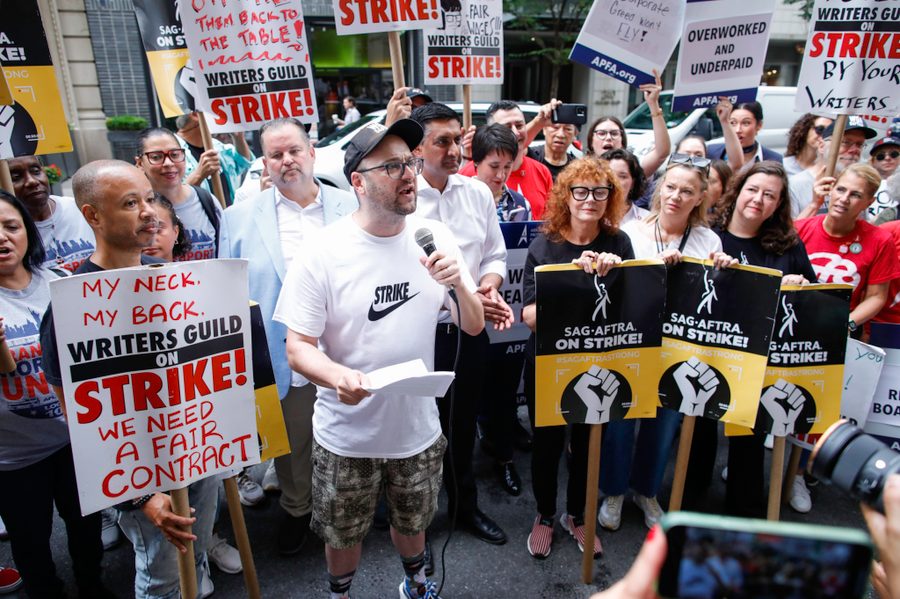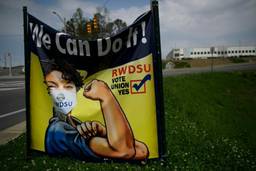Ten Predictions for Labor in 2024
Our crystal ball shows splintering coalitions, the rise of a new vanguard, and more.
Hamilton Nolan

This is the time of year when we all huddle together for warmth, reflect on the year we’ve had, and — most importantly — make highly speculative but intriguing predictions for the year ahead. That means it is time for the annual Ten Predictions for Labor: 2024 edition. See here for the Ten Predictions for Labor, 2023 — a remarkably accurate forecast if I do say so, all things considered.
Standard disclaimer: Predictions are folly and only fools make or believe them. Here we go!
- The momentum continues. The popularity of unions today is at a multi-generational high. Organized labor is getting more media attention than it has in decades. The mass disgruntlement created by the pandemic, and the structural inequality that has swallowed America over the past 40 years, have created this widespread desire for the benefits that unions offer. That is not going to change, at least not for the next 12 months. So the union establishment will get a little while longer to try to take advantage of it. However…
- Union density does not turn around. For all of the attention that individual strikes and high profile organizing campaigns get, the single most important metric of union power in America — union density — has continued to lag, despite all of labor’s popularity. The institutions of organized labor still have not figured out how to rouse themselves to pursue new organizing on a large scale. I am, sadly, pessimistic that this will be the year that changes. Prove me wrong. Please, prove me wrong! One consequence of this is…
- The energetic unions get more independent. For the past year or so, Bernie Sanders has held a series of rallies featuring Teamsters President Sean O’Brien and Association of Flight Attendants leader Sara Nelson, in an effort to heighten the public profile of unions. Most recently, United Auto Workers (UAW) President Shawn Fain joined those two in testimony to Sanders’ Senate committee. What we are seeing is that the leaders of unions who do want to organize, agitate, and generally stoke the class war in public are rising in prominence, as their more staid peers recede into the background. Expect to see more of this (and to see this group of leaders grow). If institutions like the AFL-CIO will not rise to the occasion right now, the impatient unions led by true believers will. And speaking of that…
- The UAW leads the movement. No union had a more inspiring 2023 than the UAW. In March, Shawn Fain was elected president after a successful internal democratic reform movement. He proceeded to lead a historically ambitious strike against all the Big Three automakers at once, which the UAW won. Then he called on all the nation’s unions to build up to a general strike in 2028, and announced a grand plan to organize 150,000 new workers at every non-union auto company in the country. In nine months, the UAW checked off basically the entire “Things Unions Need to Do” list. Great stuff. A+. Much hard work lies ahead, of course, but the UAW’s energy deserves applause. If that inspires jealousy in other big unions, well, that’s good. And another positive consequence…
- More internal reform movements. The UAW is living proof of what is possible when reformers win “one member, one vote” provisions and kick out entrenched bureaucracies at the top of major unions. But only six of the nation’s 20 biggest unions have that basic democratic voting structure. As a matter of basic fairness, every union should reform itself in the direction of “one member, one vote,” but as a matter of reality, reformers will have to win that measure in tedious fights. Reformers at the United Food and Commercial Workers and other big unions are already on that path. Change is coming, slowly. And on the government side…
- The NLRB gets extra frantic. The brightest spot in the Biden administration’s labor agenda has been the NLRB, where General Counsel Jennifer Abruzzo has pushed as hard as possible to reform America’s anti-worker labor regulations back in workers’ favor. Now, we’re entering what may be her last year in office. Expect to see her push to rewrite bad rules, and to hold intransigent companies like Starbucks and Amazon legally responsible for labor law violations, if such a thing is possible. And that’s good, because…
- Biden’s labor coalition splinters. Though it is a low bar, Joe Biden can rightfully claim to be the most pro-union president in three generations. The AFL-CIO endorsed him for reelection earlier than ever, hoping to keep that ball rolling. Unfortunately, it ain’t so simple. Biden crushed the railroad strike in December 2022, puncturing his pink cloud on the labor left. His policy towards Israel and Gaza has enraged even more of the left, and has prompted a number of unions to push for a cease-fire. On the right, his big happy coalition is going to be sniped by union Trump supporters in 2024. His ability to take labor for granted as a solid power base, in other words, is going to be threatened — and he has no one to blame but himself. Of the many reasons to worry about this, one is…
- First contracts in limbo. Each passing month makes it increasingly clear that the excitement of winning union drives at landmark companies like Amazon and Starbucks (and other national chains) must be tempered by the grim realization that these companies are never going to negotiate first contracts with their workers, unless they are forced to. Until unions can pull off strikes big enough to really hurt these giants, that means, on a practical level, that the federal government and the NLRB must apply inescapable pressure to make those contracts happen. Without a Democrat in the White House, expect to see those workers continue to languish without contracts for a truly shocking amount of time. Ugh. But for some sunnier news…
- More big strikes. The past year saw major strikes by the Writers Guild of America and the actors’ union SAG-AFTRA that effectively shut down Hollywood, as well as the UAW’s strike that shut down the U.S. auto industry. High profile strikes like these are good for the union members in question — both for the sake of winning better contracts, and as proof that the appetite to fight is strong — but they are also great advertisements for organized labor’s power in general. Expect to see members of other unions think back on those big wins in the coming year as they decide how hard they are willing to fight. With major contracts expiring in 2024 for postal workers, longshore workers, entertainment workers, and others, you can expect at least a few of those to push to the picket lines. We love to see it. And finally…
- You organize your workplace. You, the abstract median American, do not have a union. I guess this with confidence because only one in ten American workers is a union member today. There’s good news, though: You can have a union. You can reach out to the AFL-CIO or to the Emergency Workplace Organizing Committee and get in touch with a union organizer. (Hell, you can reach out to me if you can’t find anyone to talk to.) With the help of that organizer, and propelled by your burning desire for justice on the job — and fueled by the inspiration you have accrued by watching the bright spots of the labor movement roll on in recent years — you can pull together an organizing committee and get your coworkers to sign union cards and win an election and get certified and start bargaining a contract. I know you can. Furthermore, I predict here, in writing, that you will. This is your year to join the labor movement. Yes it is. Don’t make me a liar.
Previously: Ten Prediction for Labor in 2023, Ten Predictions for Labor in 2022
Hamilton Nolan is a labor writer for In These Times. He has spent the past decade writing about labor and politics for Gawker, Splinter, The Guardian, and elsewhere. More of his work is on Substack.








